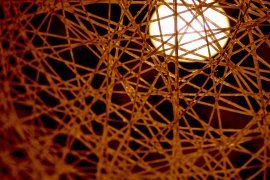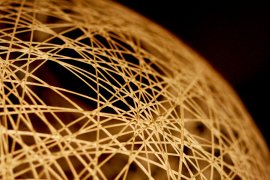|
Normally, the process for choosing a cover image for an upcoming issue of Cha is quite straightforward, and my co-editor and I come to a consensus without much trouble. This time, however, the selection proved more challenging. Almost from the beginning of our discussions, two photographs stood out from the rest. Although we briefly considered others, in the end, we found ourselves scrolling between the original two images. Perhaps surprisingly both pictures were not only taken by the same photographer, Enrica Ho (whose work you can see more of in this issue of Cha), but both were of the same subject. What made them so difficult to choose between was not, as you may expect, their similarities, but their differences. As you can see below, the images present two very different interpretations of the same frailly constructed sphere. In Picture 1, the viewer finds herself under a woven dome, gazing upward at an illuminated orb reminiscent of the moon. In Picture 2, the perspective has shifted to the outside; the viewer is now in orbit around a planet of intersecting flight plans. For us, both images were not only beautiful but presented compelling thematic possibilities. The dilemma was which one to choose.  Picture 1  Picture 2 In some ways, this was quite a high class problem to have—too much choice is undoubtedly better than not enough—but it was one that proved intractable. Eventually, we decided the only option was to ask you, our readers, to help us out by voting for the one you preferred. And you did not disappoint: your responses were both plentiful and perceptive. You also, as it turned out, ended up making our choice even harder. The votes were not as decisively one-sided as we had hoped, and your comments offered insights, which only gave us more to admire and think about. Proponents of Picture 2, for example, rightly praised its superior composition, especially its shallow depth of field and subtle investigation of shape. Others preferred the image for its evocation of freedom and otherworldliness—its feeling of celestial exploration. Finally, some of you seemed to settle on Picture 2 by default, choosing it because of qualities you disliked in Picture 1. For example, several readers said they found the moon in the first image slightly clichéd; others felt oppressed by the scene, trapped earthbound under a net. Interestingly, however, many among you who picked Picture 1, identified these exact same qualities as strengths. A number of people mentioned being enchanted by the poetic romance of the moon. Others admired the image for its reflection of our own position in the cosmos, pointed out that we too find ourselves earthbound looking up into an unattainable sky. A few of you even found comfort underneath the web; experienced not a sense of entrapment, but of being sheltered safely in a nest. Despite your feedback, however, we were still left with a choice to make, and in the end, we went with Picture 1. This is to take nothing away from the second image, which in our opinion, is probably the technically stronger of the two. However it did not affect us in quite the same way; did not, as it were, hit us where we live. And where we live is earth. To us, the second picture’s suggestion of space, of other worlds, belonged more to the realm of science fiction than to the poetry of everyday existence. (Even writers capable of the greatest flights of fancy find their feet firmly planted on the ground.) In short, it was the point of view of Picture 1, that of a terrestrial observer gazing skyward, which eventually won us over. There is a powerful familiarity and equality in this perspective. We have all seen it, we all know it. Indeed, it would be hard to think of a reference point more universal than the moon or to imagine a subject of investigation which has left civilization with more cultural legacy assets. Think for example of the calendar or the countless myths and poems devoted to the moon. Does this make it then, as several readers suggested, a clichéd theme? Yes, undoubtedly. But then again, which of the eternal themes isn’t? When you have been watched as long as the moon, you are bound to evoke a feeling of déjà vu. Much of the romance of the moon lies in exactly this sense that it has been seen before. Constancy and familiarity have been drawing gazes upward for thousands of years, and they drew ours to Enrica Ho's picture. And yet, we do not see the moon clearly in the photo; we are not offered the view of a stargazer in an untouched corner of the world. Instead we see it the way most of us do, filtered through a manmade filter. In Ho's photo, we could be looking at the moon through any number of screens: the frame of a thatched hut, the ceiling of a futuristic dome, the permanent partial eclipse of light and pollution provided by the modern city. Or perhaps we are seeing it though the metaphors of Han court astronomers who felt that "Heaven resembles a covering rain-hat, while earth is patterned on an inverted pan." Today it may be tempting to look back at such ancient interpretations of the cosmos with a certain degree of amused condescension. Our understanding of space has certainly advanced since the inverted-panners advised the Emperor on celestial matters. We classify galaxies, calculate the gravity of collapsing stars, watch the expansion of an infinitive universe. A handful of us have even walked on the moon. But despite all these accomplishments, not much has changed in our basic relationship with the sky. We may find alien an ancient emperor's reliance on astronomers to maintain his heavenly mandate, but we would not be surprised to read about a politician who seeks prestige in a space program or rocket. A few of our astronauts can claim to have seen the view from the outside, experienced the otherworldliness of orbiting a frail sphere, but most of us still remain earthbound, trapped under the dome. And like our ancestors, we are still intrigued by celestial mysteries, susceptible to the wonders of an illuminated orb. The moon continues to exert its gravitational force upon us. And even if this force is not strong enough to pull us off the inverted pan, to yank us through the rain-hat, it is enough to lift our heads skyward and make us look. Jeff Zroback / Co-editor
Cha
20 May, 2009
|